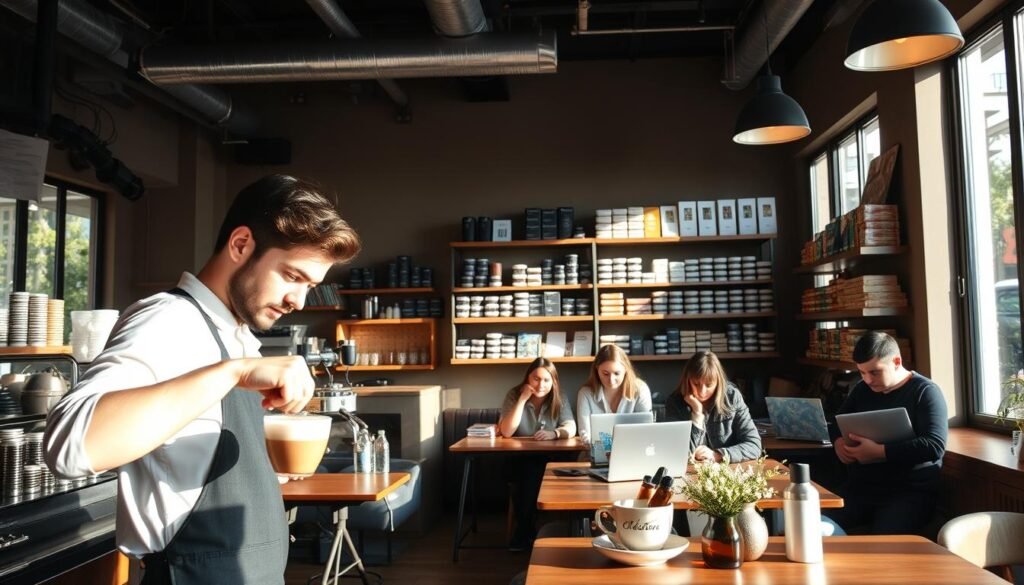Ever wondered why some coffee shops thrive while others struggle? The U.S. market has grown 30% since 2015, fueled by younger generations craving unique, artisanal experiences. But success hinges on more than just great beans—it’s about strategy, community, and smart planning.
Independent cafes flourish when they blend passion with practicality. Local support, a standout concept, and the right equipment lay the foundation. California, for example, offers booming opportunities with its coffee-loving culture.
Key Takeaways
- The U.S. coffee shop industry has expanded by 30% since 2015.
- Gen Z and Millennials drive demand for specialty drinks and cozy atmospheres.
- Community ties are critical for independent business success.
- Concept development and funding are pivotal first steps.
- Regions like California offer high growth potential.
Why Start a Coffee Shop?
The aroma of freshly brewed coffee isn’t the only thing expanding—the industry itself is booming. With specialty drinks and community-focused spaces reshaping consumer habits, entrepreneurs find unprecedented opportunities in this $48 billion market.
The Growing Coffee Industry
U.S. coffee sales grew 30% since 2015, outpacing many foodservice sectors. Specialty varieties now command 15% higher prices, with nitro cold brew and oat milk alternatives driving innovation.
Millennials lead this shift—72% choose local cafés over chains. Brands like Blue Bottle prove artisanal positioning works, combining premium beans with Instagram-worthy experiences.
Opportunities for Independent Cafés
Small shops thrive by offering what chains can’t: unique atmospheres and hyper-local connections. 64% of consumers prefer independent operators for their authentic feel and neighborhood ties.
The business model works. Successful cafés blend quality products with community events, turning first-time visitors into regulars. With 4.8% annual growth forecasted, the coffee industry remains ripe for new entrants.
How to Start a Coffee Shop: Step-by-Step Process
Navigating the journey from concept to grand opening involves critical milestones. A structured approach minimizes risks—40% of cafés fail without a formal business plan. This section breaks down the essentials: evaluating your preparedness and mapping a realistic launch timeline.
Assessing Your Readiness
Before securing funding or signing leases, audit your skills and resources. Financial management and staff training abilities are non-negotiable. Tools like SCORE’s mentorship program help fill knowledge gaps.
Budget for 6–12 months of operating costs pre-revenue. Permits often take 90 days to secure—factor this into your critical path. Shopify POS integrations streamline sales tracking from day one.
Timeline for Launch
Most independent cafés reach profitability in 6–12 months. Month 1–3 focuses on planning: finalizing your business plan and securing vendors. Months 4–6 involve funding efforts, while 7–9 cover build-out and equipment installation.
Pro tip: Host soft openings in month 10 to refine operations. This phased approach balances momentum with adaptability.
Choosing Your Coffee Shop Concept
Standing out in the crowded coffee market demands a distinctive concept. Your model—whether franchise, mobile, or niche—shapes startup costs, customer target demographics, and long-term profitability. The right choice balances passion with local demand.
Franchise vs. Independent Shop
Franchises offer brand recognition but require higher upfront costs—averaging $300K versus $150K for an independent coffee venture. Local shops thrive by tailoring menus to community tastes, while franchises face rigid corporate guidelines. Assess local competition to identify gaps.
Mobile vs. Brick-and-Mortar
Mobile units like coffee trucks generate $150K–$250K annually with lower overhead. However, brick-and-mortar locations build stronger customer loyalty. Drive-thru models boost margins by 22% by serving 45-second transactions. Check state-specific licensing for mobile operations.
Niche Ideas That Stand Out
Hybrid spaces like Capitol Books & Coffee combine caffeine with curated reads, doubling foot traffic. Cat cafés and co-working hybrids also tap into specialty audiences. Prioritize concepts aligning with neighborhood culture—art districts favor aesthetic-driven spaces, while suburbs lean toward family-friendly designs.
Writing a Winning Coffee Shop Business Plan
A well-structured business plan separates thriving cafés from those that struggle to survive. It’s your roadmap for securing funding, forecasting costs, and identifying market opportunities. According to industry data, 87% of funded shops use 5-year projections to guide decisions.
Key Sections to Include
Every effective plan covers these essentials:
- SWOT analysis: Assess strengths (e.g., artisan roasting) and threats (local competition).
- Break-even calculator: Determine monthly sales needed to cover fixed costs.
- Local market gaps: Analyze foot traffic patterns and nearby competitors’ menus.
Financial Projections Template
Use these benchmarks to build realistic forecasts:
- Sample P&L statement: A 1,200 sq ft shop averages $12K monthly revenue with 12% food costs.
- Labor controls: Keep payroll at 28–32% of revenue by cross-training baristas.
- SBA-approved templates: Streamline loan applications with pre-formatted expense sheets.
Securing Funding for Your Coffee Shop
Capital is the fuel that turns your coffee vision into reality. With average startup costs ranging from $100k–$600k, selecting the right funding mix determines your business trajectory. Nearly 60% of food ventures use blended financing—combining loans, investors, and personal savings.

Small Business Loans
The SBA approves 58% of 7(a) loan applications for food businesses, offering up to $5 million at competitive rates. Equipment financing provides another path—60-month terms spread out espresso machine costs. Portland’s Coava Coffee secured 40% of their initial capital through local credit unions before expanding nationally.
Crowdfunding Options
Food and beverage campaigns have a 34% success rate on Kickstarter. Reward tiers like “name a drink” or brewing classes engage community backers. Remember Regulation CF compliance—caps apply to non-accredited investor contributions. Successful pitches highlight unique value, like a Chicago café that raised $85k by showcasing its zero-waste model.
Cost Breakdown
Allocate $85k–$150k for build-outs including plumbing and ADA compliance. Inventory runs $25k–$50k initially for beans, milk alternatives, and pastries. Smart budgeting preserves cash flow—lease equipment until revenue stabilizes. Factor in 3–6 months of operating reserves before break-even.
Finding the Perfect Location
Visibility and accessibility define a café’s potential—strategic placement attracts steady customers. Ideal spots see 1,500+ daily pedestrians, ensuring consistent foot traffic. Tools like Placer.ai analyze walkability patterns, while visibility scores (1–5 scale) help compare sites.
Foot Traffic Analysis
Busy intersections near offices or colleges boost morning sales. Avoid areas with seasonal lulls—beach towns may drop 40% in winter. Esri Tapestry data reveals income levels and buying habits to match your concept.
Zoning Laws in the U.S.
Verify zoning codes allow food service—mixed-use districts often permit cafés. ADA compliance adds $5k–$15k for ramps and counters. Cities like Austin require 1 parking space per 100 sq ft; Portland waives it for bike-friendly builds.
Negotiating Leases
Triple net leases shift tax costs to tenants—counter with capped increases. Demand 60-day exit clauses if permits are denied. Landlords may offer 3–6 months free rent for build-outs, easing cash flow early on.
Licenses and Permits Required
Proper licensing ensures your business operates smoothly from day one. On average, cafés need 11 permits—from food service authorization to signage approval. Delays here can stall your opening, so prioritize compliance early.
State vs. Local Requirements
State requirements often set baseline rules, while cities add layers. California mandates a $15 food handler certification per employee. Localities may require grease trap installations or noise ordinances for outdoor seating.
Check zoning laws—mixed-use areas simplify approvals. Fire suppression systems cost $4k–$8k but are mandatory for kitchens. Alcohol licenses boost evening revenue but need separate applications.
Health Department Checklist
The health department inspects storage, prep areas, and employee hygiene. Follow the FDA Food Code for refrigeration temps and cross-contamination rules. Signage permits take 2–4 weeks; submit designs early to avoid delays.
Pro tip: Schedule inspections mid-week for faster turnaround. Keep digital copies of all permits accessible during checks.
Designing Your Coffee Shop Layout
A café’s physical space shapes customer experience as much as its menu. The right design balances aesthetics with functionality, ensuring smooth operations during rush hours. Strategic planning minimizes bottlenecks and maximizes efficiency—key to retaining patrons.
Front-of-House Customer Flow
Keep lines moving with a 24–30″ counter depth, allowing space for orders and payments. Studies show customers tolerate up to 7-minute waits if queues feel organized. Place pastry displays near registers to encourage add-ons.
ADA compliance is non-negotiable: tables need 27″ knee clearance and 36″ pathways. Acoustic panels dampen noise, creating a relaxed vibe even when busy.
Back-of-House Efficiency
NSF-certified shelving keeps ingredients accessible while meeting health codes. Position refrigerators near prep stations to minimize steps—every second counts during peak hours.
Ergonomic workstations reduce barista fatigue. Adjustable-height counters and anti-fatigue mats improve productivity during long shifts.
Essential Coffee Shop Equipment
Quality equipment separates thriving cafés from struggling ones. Professional tools ensure consistency, speed, and compliance with health standards. Budgeting for NSF-certified appliances upfront prevents costly upgrades later.
Espresso Machines and Grinders
Commercial-grade espresso machines like the La Marzocco Linea PB ($18k) deliver precision temperature control. Pair with conical burr grinders for uniform particle size—key to extracting balanced flavors.
Calculate ROI using a 3-year payback model. Leasing options spread costs if capital is tight. Preventative maintenance schedules extend machine lifespan by 40%.
Must-Have Smallwares
Prioritize these smallwares for daily operations:
- 5-stage water filtration: Eliminates impurities affecting taste.
- Eco-friendly disposables: Compostable cups cost 15% more but attract sustainability-focused customers.
- POS systems: Toast outperforms Square for inventory integration in high-volume shops.
Sourcing High-Quality Coffee Beans
Behind every exceptional cup is a meticulous bean selection process. Specialty-grade coffee beans scoring 85+ on the SCA scale ensure premium flavor profiles. Build relationships with trusted suppliers who prioritize freshness and traceability.
Partnering With Local or National Roasters
Local roasters offer fresher batches and collaborative menu development. Their micro-lot selections often highlight regional terroir. National suppliers provide consistency for multi-location operations but may lack seasonal flexibility.
Consider hybrid models—Portland’s Stumptown maintains quality at scale by dividing procurement between regional partners and its own roasting facilities.
Implementing Ethical Sourcing Practices
Direct trade agreements pay growers 25–40% premiums, ensuring sustainable farming. Counter Culture’s partnership with Colombian co-ops demonstrates this model’s impact—their 18-month organic certification process increased farmer incomes by 60%.
Fair Trade certification requires annual audits but builds customer trust. Display sourcing stories on menu boards to connect patrons with your values.
Hiring and Training Your Team
Your team defines the daily experience customers remember. From crafting perfect espresso shots to handling rush-hour stress, staff competency makes or breaks operations. Invest in hiring baristas who blend technical skills with genuine hospitality.
Essential Barista Skills
Look for candidates with latte art proficiency and grind size adjustment knowledge. Top performers often complete barista skills certifications like SCAA’s 20-hour curriculum. Wage ranges of $12-$18/hour plus tips attract talent in competitive markets.
Building a Training Program
Structured training boosts retention by 94%. Start with equipment mastery—espresso machine water pressure calibration takes priority. Use role-playing scenarios to sharpen customer service responses to common complaints.
Implement shift scheduling tools like Homebase to balance experience levels. Consider wage models combining hourly pay with upselling commissions. Health insurance and free shift meals are top-requested benefits in urban areas.
Building Your Coffee Brand
A strong brand identity transforms casual visitors into loyal customers. Research shows cohesive visual storytelling boosts customer recall by 68%, making every design choice a strategic investment in recognition.
Crafting a Memorable Logo
Color psychology directly impacts customer perception. Warm tones like Pantone 18-1443 (Espresso) evoke comfort, while cool blues suggest freshness. Professional designers charge $500-$2,500 but deliver scalable vector files—Canva templates work for bootstrapped budgets under $50.
Test designs across multiple formats: Does your logo remain legible on cup sleeves and Instagram thumbnails? Portland’s Deadstock Coffee nails this with a basketball-inspired mark that pops at any size.
Winning Social Media Strategies
Instagram’s 4.8% engagement rate for food businesses makes it essential. Showcase your brand personality through:
- Behind-the-scenes reels of latte art creation
- User-generated content campaigns with #MyMorningRitual
- Local influencer takeovers featuring neighborhood regulars
Geotagged posts increase discovery by 79%. Schedule posts during peak engagement windows—weekday mornings see 24% higher click-throughs for café content.
Paid social media ads perform best when targeting 3-mile radii around your location. Boost posts featuring seasonal drinks to capitalize on trending search terms like “pumpkin spice near me.”
Marketing Your Coffee Shop
Creating excitement before your doors open sets the stage for long-term success. Smart marketing strategies build anticipation and attract your first loyal customers. Focus on grassroots efforts that resonate with your local community.
Pre-Opening Buzz Tactics
Generate early interest with creative campaigns. Sidewalk chalk art featuring your logo can spark curiosity. Offer free samples at nearby events to introduce your brand.
Optimize your Google My Business profile with high-quality photos and accurate hours. List upcoming events to appear in local searches. Over 73% of customers discover new cafés through online listings.
Loyalty programs encourage repeat visits. A “10th drink free” punch card works well. Pair this with email sign-ups to grow your customer database.
Community Partnerships
Collaborate with neighboring businesses for mutual benefit. Cross-promote with bakeries by featuring their pastries. Host pop-up events at bookstores to reach new audiences.
Joining the local Chamber of Commerce provides networking opportunities. Sponsoring little league teams or school events builds goodwill. These community partnerships create authentic connections.
For your grand opening, send press releases to local media. Highlight what makes your space unique. Invite food bloggers and influencers to experience your offerings firsthand.
Hosting a Successful Soft Opening
Before the grand opening, strategic testing periods reveal operational blind spots. Nearly 88% of cafés adjust menus or workflows based on these trial runs. Limiting initial service to 50–100 guests allows staff to refine efficiency without overwhelming demand.
A soft opening doubles as a marketing tool and quality checkpoint. Digital platforms like Table Needs streamline feedback collection compared to generic Yelp forms. Mystery shoppers can assess wait times and drink consistency using standardized scorecards.
Optimizing Invite-Only Events
Target local influencers and neighborhood regulars for your guest list. Track comp ticket redemptions to identify your most engaged patrons. Staff debriefs post-event should review both customer comments and equipment performance.
Gathering Customer Feedback
Emergency scenarios—like espresso machine failures—should be simulated during these trials. Document responses to improve contingency plans. This customer feedback loop ensures your team is prepared for peak hours when doors officially open.
Keys to Long-Term Success
Turning first-time visitors into loyal regulars is the cornerstone of café profitability. With 68% of revenue typically coming from repeat customers, smart operators prioritize relationship-building alongside quality products.

Customer Retention Strategies
Implement CRM tools like SevenRooms to track preferences and visit frequency. Personalized birthday offers and anniversary discounts increase redemption rates by 40%.
Host barista championship events to showcase expertise while engaging the community. Sustainability programs, such as $0.25 discounts for reusable cups, align with eco-conscious values.
Seasonal Menu Innovation
Limited-time offers every 6-8 weeks capitalize on trends like pumpkin spice’s 23% annual growth. Rotating featured drinks create urgency—display countdown timers on menu boards.
Monitor financial health metrics weekly. Food cost percentages and labor ratios should stay below 35% to maintain healthy margins during seasonal fluctuations.
Conclusion
Launching a thriving business in this industry requires planning and passion. From securing permits to perfecting your brew, each step builds toward long-term success.
Focus on quality and community. Regular menu updates and staff training keep customers returning. Resources like SCORE mentorship and SBA loans provide ongoing support.
Every great coffee shop starts with a vision. Stay adaptable, listen to feedback, and refine operations. Your unique space can become a neighborhood staple.
Ready to take the next step? Download our free equipment checklist to streamline your setup process.
FAQ
What makes the coffee industry a good business opportunity?
The coffee industry is thriving, with steady demand and loyal customers. Independent cafés can carve out a niche by offering unique blends, quality service, and a welcoming atmosphere.
Should I open a franchise or an independent coffee shop?
Franchises provide brand recognition and support, but independent shops offer creative freedom. Consider your budget, goals, and market competition before deciding.
How much does it cost to open a coffee shop?
Costs range from 0k to 0k, depending on location, size, and equipment. Expenses include leasing, permits, staff, and high-quality beans.
What licenses and permits are needed?
Requirements vary by state and city. Common permits include health department approval, food service licenses, and fire safety inspections.
How do I find the best location?
Look for high foot traffic areas near offices, schools, or shopping centers. Analyze zoning laws and negotiate lease terms carefully.
What equipment is essential for a coffee shop?
Must-haves include an espresso machine, grinders, brewers, and refrigeration. Smallwares like tampers and frothing pitchers are also critical.
How do I source quality coffee beans?
Partner with local or national roasters who prioritize ethical sourcing. Sample different blends to find the best flavor profile for your brand.
What should I include in a business plan?
Key sections are market research, financial projections, marketing strategy, and operational details. A solid plan helps secure funding.
How can I attract customers before opening?
Build buzz through social media, local partnerships, and invite-only soft openings. Offer promotions to encourage early visits.
What’s the best way to train baristas?
Focus on brewing techniques, customer service, and efficiency. Create a structured training program to ensure consistency.
How do I keep customers coming back?
Loyalty programs, seasonal drinks, and excellent service boost retention. Engage with customers through events and social media.






